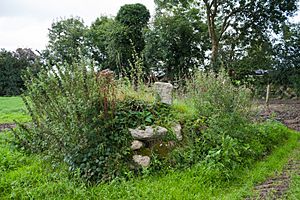Lorum High Cross facts for kids
Quick facts for kids Lorum High Cross |
|
|---|---|
| Native name Irish: Ardchros Leamhdhroma |
|

Surviving granite shaft of the cross
|
|
| Location | Lorum, Ballinkillin, County Carlow, Ireland |
| Lua error in Module:Location_map at line 420: attempt to index field 'wikibase' (a nil value). | |
The Lorum High Cross is an ancient stone cross found in Lorum, County Carlow, Ireland. It is a very old and important piece of history. Today, only a part of the cross remains. This special site is protected as a National Monument of Ireland.
This cross is part of what was once an early monastic site. Monasteries were places where monks lived and prayed a long time ago. This particular site is connected to a famous saint named Molaise of Leighlin.
What is a High Cross?
High crosses are tall, stone crosses that were built in Ireland and Britain. They are often decorated with carvings. These carvings usually show scenes from the Bible or other religious stories. High crosses were very important in early Christian Ireland. They served as markers for holy places. They also helped teach people about Christianity. Many high crosses were built between the 8th and 10th centuries.
History of Lorum's Site
The area around Lorum High Cross was once a busy monastic settlement. Monks lived and worked here many centuries ago. These settlements were centers of learning and religion. They played a big role in Irish history. The connection to Saint Molaise of Leighlin suggests the site was important. Saint Molaise was a significant figure in early Irish Christianity. He is known for founding a monastery in Leighlin.
What Remains Today?
The Lorum High Cross is not complete anymore. What we see today is mostly the lower part, or shaft, of the cross. It is made from strong granite stone. This remaining piece stands about 55 centimeters (about 22 inches) tall. It is also about 30 centimeters (about 12 inches) wide.
The cross fragment sits on a small, round mound of stones. This mound is called a cairn. The cairn measures about 210 centimeters (about 83 inches) across. Even though only a part of the cross is left, it still tells us a lot. It helps us understand the rich history of early Christian Ireland. It shows us the skill of the ancient stone carvers.

